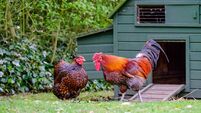Farming without nitrogen proves possible

Multi-species-sward with clover, chicory, plantain, and herbs. File Picture.
Can commercial dairy farming function without Nitrogen (N) fertilizer?
Well, according to James Humphreys, Teagasc Research Officer at Solohead Farm, the answer is yes, it can.
Mr Humphreys, who was speaking during a Signpost webinar last Friday outlined how the use of clover as a replacement for Nitrogen (N) at Solohead Farm resulted in a 16% decrease in greenhouse gas emissions prior to 2010.
“Up to 2010 we compared clover based and nitrogen-based fertiliser grassland for dairy production and found no difference in profitability but achieved a 16% reduction in greenhouse gas emissions; since then we have been looking at the extent to which we can go beyond that 16% reduction,” he added.
The current research programme at the farm is focused on white clover and 50 of the 52 hectares on the farm are clover-based swards with an average clover content of 20 to 25% receiving annual fertilizer N input of between 0 and 100kg N/ha.
The clover content of swards is around five to 15% of pasture DM during April and 35 to 45% in August/September.
“We have found that If we reduce our fertiliser N input, there is an increase in biological nitrogen fixation - around 150kg, and this is a key driver of productivity,” Mr Humphreys said.
“But when we reduce fertiliser N input in place of using biological nitrogen fixation we get no nitrous oxide or ammonia emissions and that gives us the opportunity to reduce our greenhouse gas emissions.”
He went on to say that nitrous oxide accounts for one-third of emissions from farms and is a source of ammonia, which needs to be reduced.
The challenge, Mr Humphreys added, is the pressure on Ireland to reduce emissions on farms by 2030, and doing that without impacting productivity and profitability.
Meanwhile, changes began In 2006 when the Nitrates Directive was introduced.
“There has been a lot of improvement in fertiliser management in the intervening years,” Mr Humphreys continued.
“The current recommendations are between 150-250kg of N per hectare - this depends to some extent on the inclusion of clover in the swards, the lower rates being recommended where there is plenty of clover in the sward.
“At Solohead, we have been examining clover for nearly 20 years.”
There was very little N use in Ireland prior to WW11 because it wasn’t available.
Its use coincided with cheap oil after the war and an increase in the global population.
The population went from 2bn to almost 8bn and by the 1960s and 1970s, the big concern was the rapidly growing population and how the world would feed everyone.
Mr Humphreys says fertiliser N has been a key driver of global food security.
“We see a substantial reduction in fertiliser N from around 1998 to 2011 but an increase since then because of the abolition of Milk Quota and increase in dairy cow numbers.
“Now, we are moving into a new policy agenda - The Green Deal and a 20% reduction in N use.
“If we compare Ireland to other EU countries it has a very distinctive emissions profile and we have high emissions per capita.
“On a global scale we have very high emissions per person compared to many other countries - 7.5% in the UK compared to 13.2% here.
“So, Ireland is in the spotlight in terms of meeting our emissions reduction targets and with agriculture in particular because of the large contribution it makes to our emissions.
“We need dairy cows to produce milk and we need replacements for those cows but with fertiliser use we can use different techniques to lower our emissions from fertiliser through the use of protected urea or the use of clover.”










